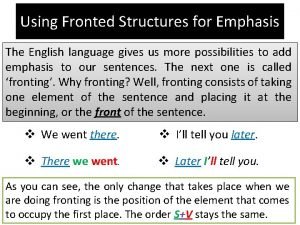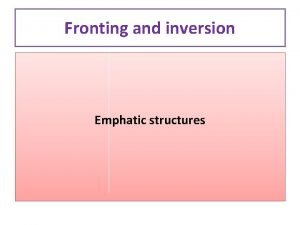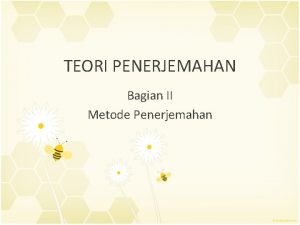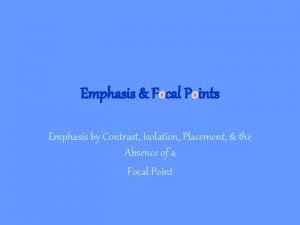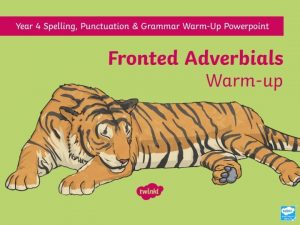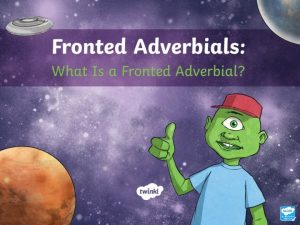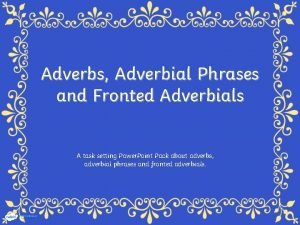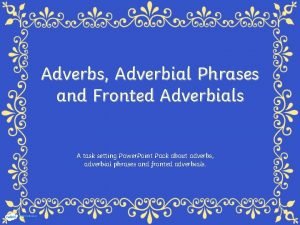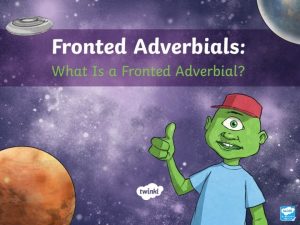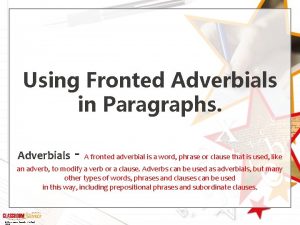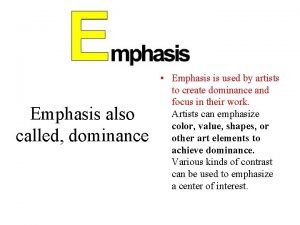Using Fronted Structures for Emphasis The English language








- Slides: 8

Using Fronted Structures for Emphasis The English language gives us more possibilities to add emphasis to our sentences. The next one is called ‘fronting’. Why fronting? Well, fronting consists of taking one element of the sentence and placing it at the beginning, or the front of the sentence. v We went there. v I’ll tell you later. v There we went. v Later I’ll tell you. As you can see, the only change that takes place when we are doing fronting is the position of the element that comes to occupy the first place. The order S+V stays the same.

Using Fronted Structures for Emphasis However, in some cases the order S+V changes and becomes V+S, like in questions, and in those cases we have what grammarians call Inversions. 1. Fronting with negative adverbs of frequency: never, rarely, seldom, and hardly ever. q I've never seen such careless work q Never have I seen such careless work. q I've rarely eaten such a delicious meal q Rarely have I eaten such a delicious meal.

2. Fronting with extend, degree, or comparison adverbial constituents. q His manner was so so absurd that everyone in in the party laughed at him. q So absurd was his manner that everyone in the party laughed at him. 3. Fronting with Present Participle (Verb + ing) q Our uncle was sitting at at the kitchen table. q Sitting at the kitchen table was our uncle.

4. Fronting with Past Participle (3 rd form of the verb) q q Several barrels of wine were hidden in in the attic q Hidden in the attic were several barrelsof ofwine 5. Fronting with adverbial of position and direction, fronting can take place with or without the subjectverb inversion. q John ran into the house. http: //www. carmenlu. com/sixth/gra mmar/inversion 61. htm q Into the house ran John/ John ran q A tree stands in in the garden q In the garden stands a tree/ aa tree stands

Cleft Sentences with wh- words Cleft sentences are used to help us focus on a particular part of the sentence and to emphasize what we want to say by introducing it or building up to it with a kind of relative clause. 1. What clauses ü They are formed with the following structure: Wh- word + info. + “be” + spotlighted info. § I enjoy teaching English at at ICPNA. § What I enjoy (most) is teaching English at ICPNA Or reverse the order § Teaching English at ICPNA is what I enjoy (most)

Cleft Sentences with Wh- words § Mr. Acevedo studied at at ICPNA § The person who studied at ICPNA is Mr. Acevedo § Mr. Acevedo is the person who studied at ICPNA § Mr. Acevedo studied at ICPNA § The place where Mr. Acevedo studied is at ICPNA § ICPNA is the place where Mr. Acevedo studied Ø The person who … Ø The reason why … Ø The place where … Ø The year/time when … Wh- word + info. + “be” + spotlighted info.

I find that hard to believe 1. (Opinion expression) art museums/zoos are (not) important or necessary in big cities. (Expression for giving more than one reason) + (Ask for agreement)

Supporting an Argument Group A Give “B” your opinion about your chosen project. Give your arguments. Introduce your counterarguments. Use expressions. Challenge B’s arguments. Use expressions. Objective: Agree on what project to support as a team. Group B Challenge A’s arguments. Use expressions. Give “A” your opinion about your chosen project. Give your arguments. Introduce your counterarguments. Use the expression.
